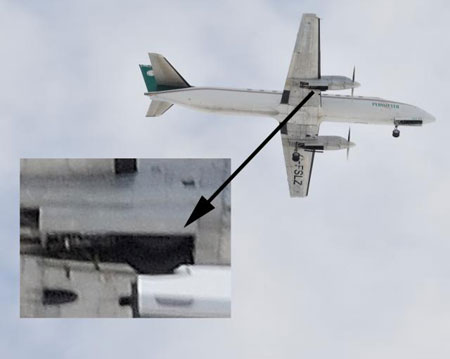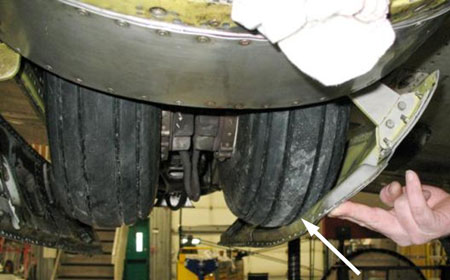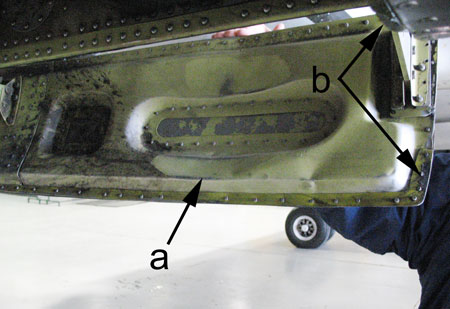Gear-Up Landing
Perimeter Aviation Ltd.
Swearingen SA226-TC Metro II C-FSLZ
Winnipeg, Manitoba
The Transportation Safety Board of Canada (TSB) investigated this occurrence for the purpose of advancing transportation safety. It is not the function of the Board to assign fault or determine civil or criminal liability. This report is not created for use in the context of legal, disciplinary or other proceedings. See Ownership and use of content. Masculine pronouns and position titles may be used to signify all genders to comply with the Canadian Transportation Accident Investigation and Safety Board Act (S.C. 1989, c. 3).
Summary
The Perimeter Aviation Limited Swearingen SA226-TC Metro II (registration C-FSLZ, serial number TC-222EE) operating as PAG Flight 640 was inbound to Winnipeg/James Armstrong Richardson International Airport from St. Theresa Point, Manitoba, with two crew members and eight passengers on board. On final approach into Winnipeg, the landing gear was selected down, but the right main gear did not extend. The crew carried out a missed approach, declared an emergency, and entered a holding pattern to attempt gear extension. The right main gear could not be extended by either the normal or emergency methods. The crew elected to conduct a gear-up landing into wind on Runway 18 with aircraft rescue and firefighting personnel standing by. Over the threshold of Runway 18, prior to touchdown, the crew shut down both engines and feathered both propellers. The aircraft came to a gradual stop on its belly on the centreline of the runway at 1209 central standard time. The aircraft was evacuated with no injuries reported. The aircraft sustained substantial damage to its propellers, flaps, and aft belly area.
Other Factual Information
The 1200Footnote 1 aviation routine weather report (METAR) for Winnipeg/James Armstrong Richardson International Airport was as follows: wind 180° true (T) at 20 knots with gusts to 30 knots, visibility 15 statute miles (sm) with drifting snow, broken clouds at 12 000 feet, temperature minus 4°C, dew point minus 7°C, altimeter setting 29.99 inches mercury. The weather was not a factor in this accident.
The flight crew was certified and qualified for the flight in accordance with existing regulations.
The aircraft was not equipped with a flight data recorder and none was required by regulation; it was equipped with a cockpit voice recorder.
The weight and centre of gravity were within the prescribed limits.
The takeoff from St. Theresa Point Airport was normal and during the flight the landing gear indicated up and locked. On approach into Winnipeg, the landing gear was selected down and the nose and left main landing gear indicated down and locked, but the right main landing gear indicated in-transit. The landing gear was recycled several times with the same result. After performing the missed approach, the crew informed air traffic control that they would need time to assess the situation and contacted the company's operations and maintenance department for assistance. The crew carried out an emergency gear extension without success.
The gear was observed from the cabin area. The left main landing gear was checked to be fully down. The right main landing gear appeared to be hung up in the wheel well area with the gear doors partially open. The inboard tire was on top of the inboard gear door (see Photo 1).
The crew briefed the passengers on the situation and after consultation with the company conducted a touch-and-go on the left main landing gear in an attempt to jar the right gear out of the wheel well. The right main gear remained in the wheel well and, with minimum fuel remaining, the decision was made to retract the landing gear and conduct a gear-up landing. After the aircraft came to a stop, the passengers were deplaned through the main cabin door with aircraft rescue and firefighting personnel standing by.
The aircraft was lifted from the runway and the emergency gear handle was pulled. All three landing gear immediately free fell from their respective wheel wells and the landing gear was hand pumped to the down and locked position. The aircraft was towed to the operator's maintenance facility for further examination.
The aircraft was placed on jacks and inspected. The main landing gear doors, flaps, and aft belly area had abrasions and damage from scraping along the runway. The right inboard gear door had a pronounced bend on the outer skin panel and an indentation in the raised inner skin panel with rub marks from contact with the number three tire.Footnote 2 There was no indication that the door had been damaged prior to the flight. The leading edge of the gear door and the aft nacelle channel stop had fretting and wear marks from contact with each other (see Photo 3). Due to the damage to the door, the inboard gear door rigging could not be checked. The gear door actuator linkage rod (used to adjust the gear door) was observed to be approximately 1/8 to 3/16 inch shorter than the other three gear door link rods. Some free play was noticed in the gear door bushings/linkage arrangement, but the free play was not considered excessive. The right outboard gear door hinge was observed to be rigged tight against the inner wheel well keelson while in the open position. Section 32-30-00 of the M7 Aerospace SA226 Series Maintenance Manual specifies a minimum clearance of 0.063 inch (see Appendix A).
A gear swing was carried out and the gear swung freely with no hang-ups. The clearance between the number three tire and the inner gear door was tight, but the tire passed freely due to the pronounced bend in the gear door. The inner and outer door panels were straightened as a temporary repair to facilitate troubleshooting, but the original rigidity of the door could not be maintained. Subsequent gear swings were carried out and it was noticed that during gear extension the number three tire would catch momentarily on the raised inner skin panel, but the door would flex and the tire would slide by. A side load was placed on the gear door to account for anticipated air loads during flight. The number three tire caught and jammed on a ledge area of the raised inner skin panel (see Photo 2), stopping the gear extension and bending the gear door as observed after the occurrence (see Photo 3).
The tires were dimensionally checked and the number three tire was found to be approximately one-half inch greater in diameter than the number four tire. The number three tire was a newly re-capped 19.5 x 6.75 inch Michelin tire that was installed on 15 February 2009, 58 flight hours or 73 airframe cyclesFootnote 3 prior to the occurrence. The number four tire was a new (not re-capped) Michelin 19.5 x 6.75 inch tire that was installed on 23 February 2009, 32 flight hours or 32 airframe cycles prior to the occurrence. The number three tire that was removed on 15 February 2009 could not be dimensionally checked because it had been removed from service and was no longer available.
The aircraft manufacturer issued a Fairchild Aircraft Corporation Tips and Service (FACTS) publication introducing Service Note 226-SN-131 on 21 May 1984 with the latest revision on 12 September 1990. The FACTS letter stated that because of the accepted practice of using re-capped tires on most commercial aircraft, differences in tire dimensions after re-capping can cause interference problems in the wheel wells, particularly in the main gear wells. The service note provided instructions to control the maximum dimensions of new tires to preclude interference of the tire in the wheel well that could cause tire-related gear hang-ups. The maximum allowable outside diameter of a new tire was set at 19.2 inches with a maximum shoulder width of 6.35 inches. The service note provided instructions to build a template to use in the measurement of a new tire. The service note further explained that the dimensions of all new tires will increase once in use,Footnote 4 but the maximum tread diameter of a used tire should not exceed 19.7 inches and a maximum shoulder width of 6.6 inches.
The number three and number four tires were checked using the template prior to installation on the aircraft and were found to be within acceptable limits. After the occurrence, the tires were checked against the new tire template dimensions. The number four tire was measured at 18.75 inches. The number three tire was measured at 19.25 inches—just beyond the new tire limit of 19.20 inches, but well below the used tire limit of 19.7 inches.
The gear door is designed with a raised inner panel to offer rigidity to the door, but the design has the undesirable effect of providing a ledge that could snag a tire. The gear doors on the later production Fairchild SA227 Metro III/23 aircraft were re-designed to remove the ledge shape (see Photo 4).
A review of the aircraft's technical records indicated that the most recent work done on the right main landing gear doors was on 25 September 2008 on a Phase 8Footnote 5 inspection, 513 flight hours or 663 cycles prior to the accident. The right main gear inboard door was removed for sheet metal repair. The gear door was repaired and reinstalled along with a new aft hinge. Both the forward and aft hinge bushings were replaced due to wear. The gear door fit was functionally inspected as per Form 31Footnote 6 and the requirements of the Phase 8 inspection. Form 31 calls for a visual inspection of the landing gear doors to ensure that they are closed and faired, but not so tight as to prevent the gear from locking in the UP position. A visual inspection relies on the experience of the maintainer.
Section 32-30-00 of the M7 Aerospace SA226 Series Maintenance Manual specifies that, after gear door installation, or maintenance on the gear doors or door operating components, the gear doors are to be rigged using procedures outlined in the maintenance manual. As part of the procedure, the door linkage is disconnected and the landing gear is fully retracted with the weight of the gear resting on the uplock hook. The doors are closed individually and the door actuating linkages are adjusted to obtain a flush fit. This procedure ensures that the doors are not rigged too far up against the aft nacelle channel stop. Tight rigging would reduce clearances between the tire and gear door during gear extension and retraction. There is no record to indicate that the gear doors were rigged in accordance with the requirements of the maintenance manual. The lack of a maintenance record does not necessarily mean that the rigging task was not completed. Phase 2Footnote 7 and Form 31 inspections were subsequently completed on 07 January 2009, 188 flight hours prior to the accident.
On 15 December 2008, the right main gear did not indicate up and locked after gear retraction. A gear swing was carried out and the fault could not be duplicated. The gear was lubricated and the aircraft was returned to service; however, the fault reappeared the following day. The right inboard landing gear actuator rod was adjusted to bring the landing gear further against the uplock hook and the fault did not recur. On 02 March 2009, the day prior to the accident, the right main gear had an intermittent uplock indication on the first flight of the day. The flap and gear indicator unit was replaced and the gear-up limit switches were cleaned. A gear swing was carried out without fault and the aircraft was returned to service. On both occurrences, the gear door clearances would have been checked as part of the troubleshooting and gear swing requirements.
Analysis
The inability of the right landing gear to fully extend from the wheel well resulted from interference between the number three tire and the inboard gear door. A combination of several factors likely came into play to cause the tire to interfere with the gear door.
The right inboard landing gear door was rigged too tightly in the retracted position. The right outboard gear door hinge was also observed to be rigged too tightly against the inner wheel well keelson in the open position. The work done to the inboard gear door during an inspection in September 2008 could have affected the geometry and fit of the door. A rigging check was required after this work, and there is no record that it was done, other than the visual inspection required by Form 31, which relies on the experience of the maintainer. The lack of a maintenance record does not mean that a rigging check was not carried out, but the rigging discrepancies noted on both right main gear doors should have been resolved. After the repair to the gear door during the Phase 8 inspection, the doors were visually inspected on three occasions, and there is no record to indicate that the gear doors were adjusted. Thus, the mis-rigging of the gear doors likely went unnoticed through four separate inspections.
The incorrectly rigged gear door would have reduced the clearance between the tire and gear door during retraction and extension. This in itself would likely not have caused the interference problems experienced in this occurrence because the aircraft operated for 663 cycles without incident.
Sixteen days or 73 cycles before the accident, the number three tire was replaced with a re-capped unit. The tire was within the new tire specification when installed, but grew in dimension until it measured just beyond the new tire limit at the time of the accident, but well below the used tire limit. The manufacturer's specification sheet indicates that new full tire dimensioning will generally occur within 50 cycles of operation. It is likely that the tire growth would have been small as stretching of the nylon fabric carcass would have occurred during tire use prior to the re-capping process; however, it grew to a size approximately one-half inch larger in diameter than the new tire installed in the number four position 32 cycles prior. The number three tire that had been replaced could not be checked for used tire dimensions, but it is likely that the tire was of smaller diameter than the replacement tire because no interference problems were encountered during its time in service.
Some free play was noted in the gear door bushings/linkage arrangement, but it was not considered excessive. The bushings would have gradually worn in service during the 663 cycles since replacement, resulting in a small delay in the opening sequence of the gear doors due to the air loading. The combined effect of a mis-rigged gear door and the installation of a new re-capped tire with larger dimensions, coupled with growing free play in the gear door bushings/linkage arrangement and air loading on the gear door reduced clearances sufficiently that the right inboard tire caught on a ledge on the inboard door skin, preventing the right main gear from extending.
Findings
Findings as to causes and contributing factors
- The right inboard landing gear door was incorrectly rigged, which reduced the clearance between the tire and gear door during gear extension. The mis-rigged landing gear door likely went unnoticed through four separate inspections.
- The combined effect of the mis-rigged gear door, the installation of a new re-capped tire with large dimensions, growing free play in the gear door bushings/linkage arrangement, and air loading on the gear door reduced clearances sufficiently that the number three tire caught on a ledge on the inboard door skin, preventing the right main gear from extending.
Finding as to Risk
- The design of the landing gear places the tires and gear doors in close proximity to one another during operation. The gear door is designed with a ledge area on the inner door skin that can put the tire at risk of becoming snagged if proper tire size and gear door rigging are not ensured.
Other Finding
- In later production Fairchild SA227 Metro III/23 aircraft, the ledge area on the inner door skin was re-designed with a shallower profile area, which somewhat alleviates the tire clearance issue.
Safety action
After the occurrence, the operator immediately conducted a risk assessment through its internal safety management system (SMS). A critical fleet inspection was undertaken to mitigate the risk of recurrence and several potential areas of safety action were identified. A review of Form 31 of its inspection program was begun with the purpose of including a check for indication of tire rub or damage due to door/tire contact, as well as a more detailed rigging check to focus on specific areas of the landing gear, like the nacelle channels and stops. The tire measurement tool was modified to reduce the maximum allowable new tire diameter from 19.2 inches to 18.95 inches, and tires that exceeded those limits were removed from stores. The company is also investigating the feasibility of modifying its gear doors to reduce or eliminate the possibility of interference.
The manufacturer, M7 Aerospace, re-issued the May 1984 Fairchild Aircraft Corporation Tips and Service (FACTS) tire size information in its current March 2009 FACTS publication.
This report concludes the Transportation Safety Board's investigation into this occurrence. Consequently, the Board authorized the release of this report on .




